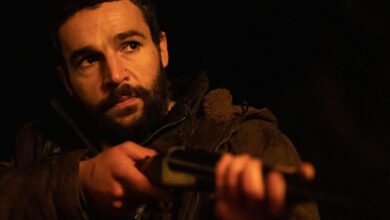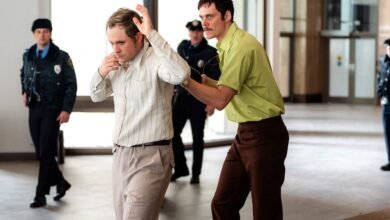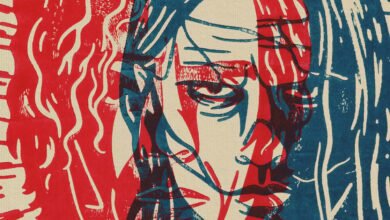The wild, wacky tale of Wallace and Gromit: Curse…


Change was in the air at Aardman Animation in the early 2000s. After decades of making a name for themselves through animated ads and celebrated shorts, it was only natural for the studio to get bigger. “I personally think of the Aardman story as being very linear,” says co-founder Peter Lord, talking to Little White Lies over Zoom. “That’s my optimistic post-rationalisation. We started out as two school boys, did a bit of work, had a little breakthrough with Morph, had good luck and good timing, and a company that started with two guys ended up with hundreds and hundreds.”
Those two school boys – Peter Lord and David Sproxton – almost exclusively carried the burden of the studio from its formation in 1973 until the late 80s and early 90s when Aardman hired its first batches of employees. Amongst them were Nick Park and Steve Box, the two men who would go on to direct 2005’s Wallace & Gromit: Curse of the Were-Rabbit, Aardman’s follow-up to their first theatrical release, Chicken Run, and the feature-length debut of Park’s already iconic man-and-dog duo.
Get more Little White Lies
“I remember my payslip being 007 which I always loved,” Box recalls. “I fondly remember that time because it was so tiny then, you just did every job; building the models, animating, doing the camera work, sound effects – you did the lot. But after Chicken Run, it was big. The films had 100-plus people on them. Chicken Run changed the company a lot.”
It’s difficult to imagine Aardman without Chicken Run, but it was never in Lord’s long-term plans for Aardman. “We’d never dreamt of a movie-length project at all. I remember sitting on a stage at the Annecy Film Festival and saying in a confident voice, ‘I don’t suppose we’ll ever make a feature film.’ At the time, it seemed impossible. It’s amazing how the world changed. I’m old enough to remember the days when it was Disney or nothing, so to make a feature that wasn’t Disney and was stop-motion seemed fairly incredible.”
One of the main factors in Aardman going feature length was Jeffrey Katzenberg – the former Disney exec who, in the late 90s, had left Disney and formed DreamWorks alongside Steven Spielberg and David Geffen. “He loved Wallace & Gromit,” says Box. “He courted Aardman for years. Even when he was at Disney he was trying to get them to make a feature. One of the reasons why Wallace & Gromit wasn’t the first film is because they wanted Nick to sign the rights to the characters away.” Park held strong, and Chicken Run was made in the meantime – a film that still holds the record as the highest grossing stop motion feature of all time. Aardman had cracked the feature code, and with a bonafide success under their belts, it was Wallace & Gromit’s turn to bat.
For Box, Wallace & Gromit’s short film history softened the leap to feature length. “The Wrong Trousers was a turning point where Wallace & Gromit started to feel more cinematic,” Box explains. “It was very influenced by film noir, Hitchcock and British movies like Odd Man Out. Irrespective of the length, that felt like a mini feature film, so it didn’t feel like we had to do something major to make the step-up.”
Lord knew that Park and Box’s idea of a “vegetarian horror movie” had potential, but selling it to DreamWorks would be a big challenge. “There was a pitch to Jeffrey much later that was two hours long or something,” remembers Lord. “Bless him – Jeffrey was very tolerant of this very elaborate, rather uncertain pitch because he could see the gold in it. I think Steve played a little tune on the ukulele as part of it to describe some parts of the story. God help us.”
Curse of the Were-Rabbit sees Wallace’s hare-brained attempt to brainwash a bunny into removing vegetables from its diet in order to save the villagers’ vegetable patches backfire spectacularly, accidentally transforming him into a hopping beast under a full moon. Wallace’s affiliation terrorises the town, mutilating marrows and sacrificing his potential romance with Lady Tottington while drawing the ire of his love rival Victor.
Despite being so deeply original, Were-Rabbit is steeped in folk horror tropes – something Box was excited to lean into, “We loved all the old Hammer Horror and Universal films. We watched all of them when we were developing Were-Rabbit and you kept seeing these similar characters. In Curse of the Werewolf, which Peter Sallis [who voiced Wallis until his death in 2017] is also in, there’s a brilliant character of the Vicar who people would run to once the werewolf attacks started happening. Then with Victor and Lady Tottington, that was all inspired by the class comedy in British films. In The Hound of the Baskervilles you have these toffs that are up to no good. We really enjoyed the idea that the real arch enemy was going to be this upper class blood sports fanatic.”
But while cooking up whacky ideas of their own, Park and Box were often met with interference from DreamWorks. Notes upon notes attempting to make Wallace & Gromit a bit less British would land in their lap – among them suggestions that Wallace have a sports car and wear trendy sneakers. A few small details that the American studio found lost in translation ended up as big arguments. “There was one note in particular where we really did fight back in the end,” recalls Box. “I had this really old car and I was forever having trouble with my trunnions. I remember the guy in the garage saying ‘so you’ve buckled your trunnions’, whatever the hell they are, I don’t know, but that sounded like a nice phrase. It sounds a bit Northern. So in one scene Gromit is driving like crazy to get Wallace home because knows he’s about to transform. You see the little truck belting down this track, and Wallace says, ‘Steady on lad, you’ll buckle me trunnions.’ It was so funny, but that led them to send a whole list of things they didn’t understand in the entire movie.” Lord points to one key thing as the reason why DreamWorks didn’t get their way: “They’re Nick’s characters. We were in a strong position to say no.”





